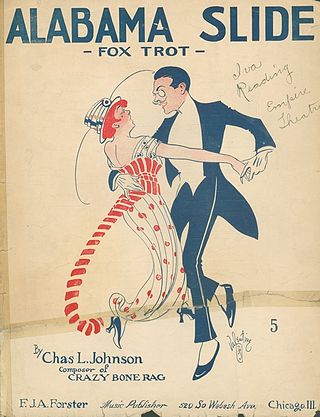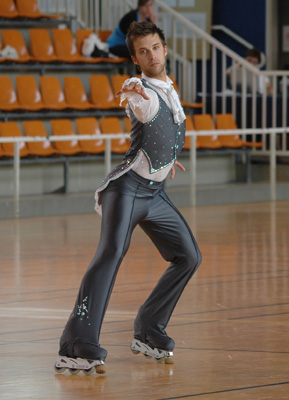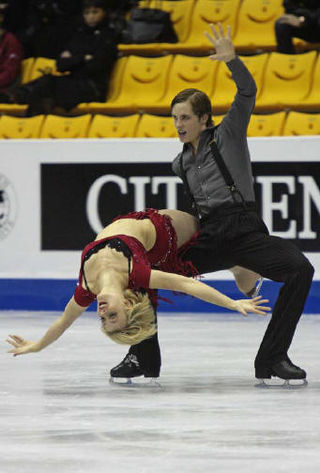
Ballroom dance is a set of partner dances, which are enjoyed both socially and competitively around the world, mostly because of its performance and entertainment aspects. Ballroom dancing is also widely enjoyed on stage, film, and television.

Ice dance is a discipline of figure skating that historically draws from ballroom dancing. It joined the World Figure Skating Championships in 1952, and became a Winter Olympic Games medal sport in 1976. According to the International Skating Union (ISU), the governing body of figure skating, an ice dance team consists of one woman and one man.

The foxtrot is a smooth, progressive dance characterized by long, continuous flowing movements across the dance floor. It is danced to big band music. The dance is similar in its look to waltz, although the rhythm is in a 4
4 time signature instead of 3
4. Developed in the 1910s, the foxtrot reached its height of popularity in the 1930s and remains practiced today.

Modern social round dance, or round dancing, is a choreographed and cued ballroom dance that progresses in a circular counter-clockwise pattern around the dance floor. The two major categories of ballroom dances found in round dancing are the smooth and international ballroom styles and the Latin dances. It is not to be confused with circle dancing, which is a type of folk dance in which dancers are connected in a circular chain.
This is a list of dance terms that are not names of dances or types of dances. See List of dances and List of dance style categories for those.
The New Vogue dance style is an Australian form of sequence dancing that originated in the 1930s. Since then it has become an important part in the Australian and New Zealand ballroom scene, holding as much importance in social and competition dancing as Latin or International Standard dances.

Artistic roller skating is a competitive sport similar to figure skating but where competitors wear roller skates instead of ice skates. Within artistic roller skating, there are several disciplines:

Sequence dancing is a form of dance in which a preset pattern of movements is followed, usually to music which is also predetermined. Sequence dancing may include dances of many different styles. The term may include ballroom dances which move round the floor as well as line, square and circle dances.
The following is a glossary of figure skating terms, sorted alphabetically.
The short program of figure skating is the first of two segments of competitions, skated before the free skating program. It lasts, for both senior and junior singles and pair skaters, 2 minutes and 40 seconds. In synchronized skating, for both juniors and seniors, the short program lasts 2 minutes and 50 seconds. Vocal music with lyrics is allowed for all disciplines since the 2014-2015 season. The short program for single skaters and for pair skaters consists of seven required elements, and there are six required elements for synchronized skaters.
The free skating segment of figure skating, also called the free skate and the long program, is the second of two segments of competitions, skated after the short program. Its duration, across all disciplines, is four minutes for senior skaters and teams, and three and one-half minutes for junior skaters and teams. Vocal music with lyrics is allowed for all disciplines since the 2014—2015 season. The free skating program, across all disciplines, must be well-balanced and include certain elements described and published by the International Skating Union (ISU).

Keiffer J. Hubbell is an American ice dancer. He competed with his sister Madison Hubbell from 2001 to 2011. They are the 2010 Four Continents bronze medalists, two-time U.S. pewter medalists, and 2006 Junior Grand Prix Final champions.

The original dance (OD) was one of the programs performed by figure skaters in ice dance competitions, in which the ice dancers skated "a dance of their own creation to dance music they have selected for the designated rhythm(s)". It was normally the second of three programs in the competition, sandwiched between the compulsory dance (CD) and the free dance (FD). The rhythm(s) and type of music required for the OD changed every season, and were selected by the International Skating Union (ISU) before the start of the season. The ice dancers were free to choose their own music and choreography and to create their own routines. They were judged on a set of required criteria, including skating skills and how well they interpreted the music and the rhythm.

Season six of Dancing with the Stars premiered on March 17, 2008.
British Ice Skating is the national governing body of ice skating within the United Kingdom. Formed in 1879, it is responsible for overseeing all disciplines of ice skating: figure skating ; synchronised skating; and speed skating.
The 2006 Czech Figure Skating Championships were held in České Budějovice between December 15 and 18, 2005. Skaters competed in the disciplines of men's singles, ladies' singles, pair skating, and ice dancing on the senior, junior, and novice levels.
The 2010 NRW Trophy was held in two parts, with ice dancers competing separately from the singles disciplines and pair skating. Both competitions were held at the Eissportzentrum Westfalenhalle in Dortmund. The ice dancing competition was held between November 5 and 7, 2010, and the other disciplines between December 2 and 5, 2010. Skaters competed in the disciplines of men's singles, ladies' singles, pair skating, and ice dancing across the levels of senior, junior, and novice. In addition, the ice dancing competition includes a pre-novice division.
The 2011 NRW Trophy was an international figure skating competition during the 2011–2012 season. An annual event organized by the Skating Union of North Rhine-Westphalia (NRW), it has been sanctioned by the Deutsche Eislauf Union and the International Skating Union since 2007.

The compulsory dance (CD), now called the pattern dance, is a part of the figure skating segment of ice dance competitions in which all the competing couples perform the same standardized steps and holds to the music of a specified tempo and genre. One or more compulsory dances were usually skated as the first phase of ice dancing competitions. The 2009–10 season was the final season in which the segment was included in International Skating Union (ISU) junior and senior level competition. In June 2010, the ISU replaced the name "compulsory dance" with "pattern dance" for ice dance, and merged it into the short dance (SD) beginning in the 2010–11 figure skating season.
The rhythm dance (RD) is the first segment of an ice dance competition. The International Skating Union (ISU) renamed the short dance to the "rhythm dance" in June 2018, prior to the 2018–2019 season. It became part of international competitions in July 2018. French ice dancers Gabriella Papadakis and Guillaume Cizeron hold the highest RD score of 90.83 points, which they achieved at the 2022 Beijing Winter Olympics.








